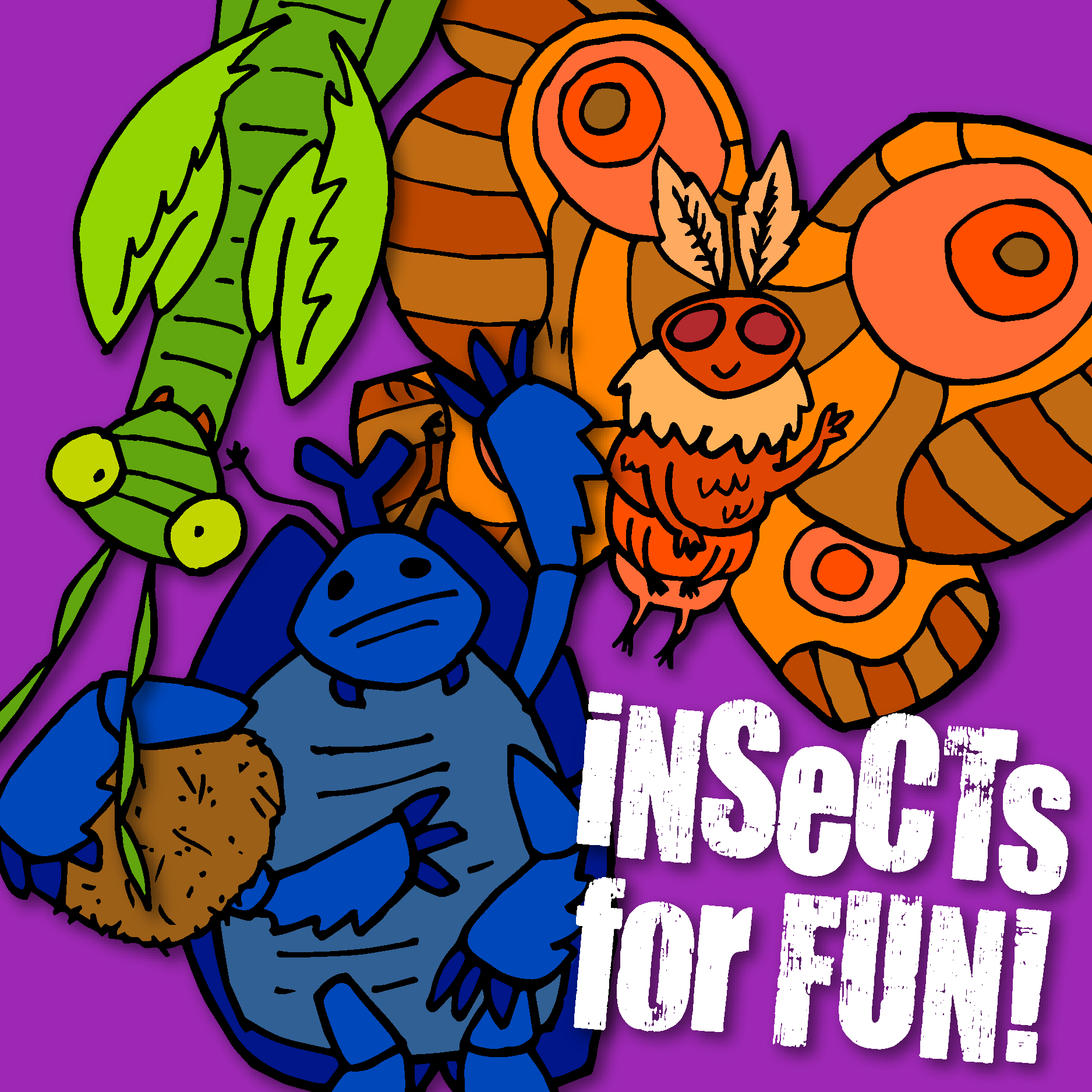Insects for Fun!
An informational podcast covering all things insect and arthropod, hosted by a master in entomology! Join me every Tuesday to learn something new from notable species to broad topics and lore! You can support the show and get extra episodes here: patreon.com/user?u=46499107 Email: Insectsfordummies@gmail.com

Welcome to Insects for Fun!
It doesn't matter if you love or hate insects; this podcast is for everyone! Let's dive into a strange world and uncover crazy facts and mysteries about all things entomology!
Episodes

Tuesday Feb 27, 2024
Tuesday Feb 27, 2024
This week we look at Harvestmen! The strange spider-like but not quite spider arthropods that roam the earth. We'll go over some fun names, myths, legends, behaviors, and defenses!
Patreon -> https://www.patreon.com/user?u=46499107
IG: https://www.instagram.com/insects4fun/
FB: https://www.facebook.com/profile.php?id=100085443614825
Email: Insectsfordummies@gmail.com
Discord -> https://discord.gg/pDJH3CYcG6
Music featuring artists: HM Surf, Squeeda, Brillion, and Takada Fu.

Tuesday Feb 20, 2024
Tuesday Feb 20, 2024
This week we look at the booming and lucrative business of isopods as pets! Let's dive into the different options, and prices for designer isopods, and how to build their enclosures and care for them.
Patreon -> https://www.patreon.com/user?u=46499107
IG: https://www.instagram.com/insects4fun/
FB: https://www.facebook.com/profile.php?id=100085443614825
Email: Insectsfordummies@gmail.com
Discord -> https://discord.gg/pDJH3CYcG6
Music featuring artists: Kei Kawaguchi, Takada Fu, and Toshiki Hayashi

Tuesday Feb 13, 2024
Tuesday Feb 13, 2024
This week we look at one of America's most venomous caterpillars and learn about some of their unique traits along with what happens if you get stung.
Patreon -> https://www.patreon.com/user?u=46499107
IG: https://www.instagram.com/insects4fun/
FB: https://www.facebook.com/profile.php?id=100085443614825
Email: Insectsfordummies@gmail.com
Discord -> https://discord.gg/pDJH3CYcG6
Music from Lofi Girl featuring: HM Surf and S N U G.

Tuesday Feb 06, 2024
Tuesday Feb 06, 2024
Today we are taking a look at some crazy looking insects known as Harlequin beetles. This beetle is so unique that it doesn't share any relatives under its genus, but its uniqueness goes beyond appearance...
Patreon -> https://www.patreon.com/user?u=46499107
IG: https://www.instagram.com/insects4fun/
FB: https://www.facebook.com/profile.php?id=100085443614825
Email: Insectsfordummies@gmail.com
Discord -> https://discord.gg/pDJH3CYcG6
Music from Lofi Girl featuring: HM Surf and Brillion.

Tuesday Jan 30, 2024
Tuesday Jan 30, 2024
This week we look at the top 3 most used and well-known composter eaters, and how you can raise them for your own garden and compost needs.
Patreon -> https://www.patreon.com/user?u=46499107
IG: https://www.instagram.com/insects4fun/
FB: https://www.facebook.com/profile.php?id=100085443614825
Email: Insectsfordummies@gmail.com
Discord -> https://discord.gg/pDJH3CYcG6
Music from Lofi Girl featuring: S N U G, Sátyr, and Phlocalyst.

Tuesday Jan 23, 2024
Tuesday Jan 23, 2024
This week we look at burying beetles in the subfamily Nicrophorinae aka Sexton Beetles, and what separates them from other beetles. Learn about their life cycles, behaviors, relationships with others, and more!
Patreon -> https://www.patreon.com/user?u=46499107
IG: https://www.instagram.com/insects4fun/
FB: https://www.facebook.com/profile.php?id=100085443614825
Email: Insectsfordummies@gmail.com
Discord -> https://discord.gg/pDJH3CYcG6

Tuesday Jan 16, 2024
Tuesday Jan 16, 2024
This week we look at two different species of weevils known as Giraffe weevils, but these two species aren't closely related at all. We learn why both are referred to as giraffes and what makes them special.
Patreon -> https://www.patreon.com/user?u=46499107
IG: https://www.instagram.com/insects4fun/
FB: https://www.facebook.com/profile.php?id=100085443614825
Email: Insectsfordummies@gmail.com
Discord -> https://discord.gg/pDJH3CYcG6
Music from lofi girl featuring: HM Surf, Sátyr, and Phlocalyst.

Tuesday Jan 09, 2024
Tuesday Jan 09, 2024
This week we dive into some unique insects that give birth to their babies instead of laying eggs, and how they do it!
Patreon -> https://www.patreon.com/user?u=46499107
IG: https://www.instagram.com/insects4fun/
FB: https://www.facebook.com/profile.php?id=100085443614825
Email: Insectsfordummies@gmail.com
Discord -> https://discord.gg/pDJH3CYcG6
Music from Lofi Girl featuring HM Surf, mell-ø and other Japanese artists like Shingo Sekigu and Takada Fu.

Tuesday Jan 02, 2024
Tuesday Jan 02, 2024
This week we are going back in time to look at some noteworthy ancient insects, how they were different from today, and why they're now gone.
Discord -> https://discord.gg/pDJH3CYcG6
Patreon -> https://www.patreon.com/user?u=46499107
IG: https://www.instagram.com/insects4fun/
FB: https://www.facebook.com/profile.php?id=100085443614825
Email: Insectsfordummies@gmail.com
Music from Lofi Girl featuring: HM Surf, Brillion, and Blue Wednesday

Tuesday Dec 19, 2023
Tuesday Dec 19, 2023
This week we are talking about the Australian Christmas beetles! What they are, what makes them special, and how their festive looks protect them from heat.
Discord -> https://discord.gg/pDJH3CYcG6
Patreon -> https://www.patreon.com/user?u=46499107
IG: https://www.instagram.com/insects4fun/
FB: https://www.facebook.com/profile.php?id=100085443614825
Email: Insectsfordummies@gmail.com
Music from Lofi Geek










